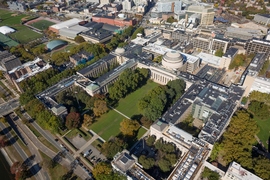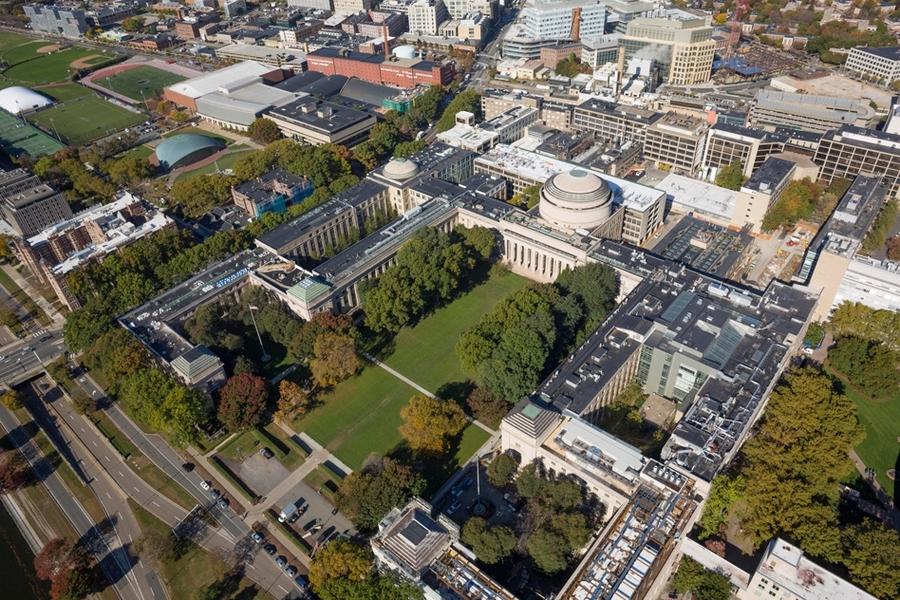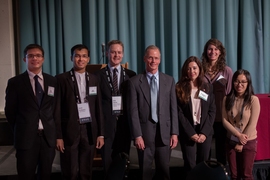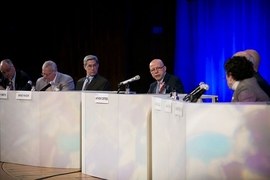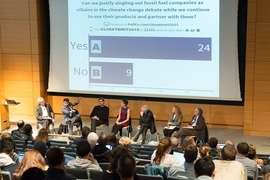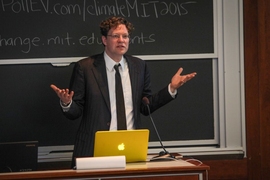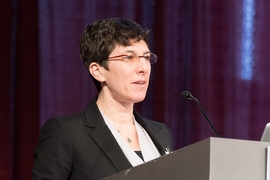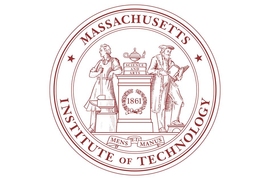MIT is launching a multifaceted five-year plan aimed at fighting climate change, representing a new phase in the Institute’s commitment to an issue that, the plan says, “demands society’s urgent attention.”
Citing “overwhelming” scientific evidence, “A Plan for Action on Climate Change” underscores the “risk of catastrophic outcomes” due to climate change and emphasizes that “the world needs an aggressive but pragmatic transition plan to achieve a zero-carbon global energy system.”
To that end, MIT has developed a five-year plan to enhance its efforts in five areas of climate action, whose elements have consensus support within the MIT community:
- research to further understand climate change and advance solutions to mitigate and adapt to it;
- the acceleration of low-carbon energy technology via eight new research centers;
- the development of enhanced educational programs on climate change;
- new tools to share climate information globally; and
- measures to reduce carbon use on the MIT campus.
The plan calls for MIT to convene academia, industry, and government in pursuit of three overlapping stages of progress.
“The first step,” according to the plan, “is to imagine the future as informed by research: e.g., What is the optimal mix of energy sources in 15, 25 and 35 years, in order to meet emissions targets and eventually reach a zero-carbon global energy system? And how can societies across the globe best adapt to damaging climate impacts in the meantime?”
“Next,” the plan continues, “it will be vital to establish the policy and economic incentives to achieve that future. Finally, clear technological goals and aligned incentives will focus and accelerate the research and development required to achieve success. All three phases need to be continuously refreshed: Research and development should continuously inform timelines and targets. The success of this strategy depends on the best efforts of all three sectors.”
The plan specifically asserts the need for a price on carbon in order to align the incentives of industry with the imperatives of climate science.
The plan also announces that MIT will not divest from the fossil fuel industry. This decision and the overall plan emerged from more than a year of broad consultation with the MIT community, including extensive public discussion led by the Committee on the MIT Climate Change Conversation, and engagement with the student-led group Fossil Free MIT. This group originally petitioned MIT to divest from 200 companies and more recently has asked for “reinvestment in campus sustainability, and a reinvention of the approach that MIT takes toward climate change.”
In his announcement letter today to the MIT community, President L. Rafael Reif said the plan would not have taken the shape it did without Fossil Free MIT’s “willingness to work with us toward the shared goal of meaningful climate action.” He encouraged the group’s members to join in the work ahead.
A call to service, on campus and beyond
In his letter, Reif called upon all members of the MIT community to take action. “There is room and reason for each of us to be part of the solution,” he wrote. “I urge everyone to join us in rising to this historic challenge.”
Alumni are being called upon to imagine how they can help MIT execute the plan. A competition announced in the plan has been created in order to elicit the most effective ways for the MIT alumni community to take personal and combined action.
“MIT’s 130,000 alumni represent an exceptional untapped resource for driving substantive progress on climate change,” the plan says, “and we are certain that our graduates will know better than we do how to make the most of their strength, from their technical expertise to their professional and community networks.”
The competition will be hosted by the MIT Climate CoLab, a digital community that engages nearly 50,000 people from over 170 countries to crowdsource climate priorities and novel solutions. The plan calls for the Climate CoLab to expand its overall capacity, so that MIT can serve as a vital hub of crowdsourced solutions to climate change.
A year and more in the making
The plan is the result of an MIT-wide initiative on climate launched in May 2014, and led by Provost Martin Schmidt; Vice President for Research Maria Zuber; MIT Energy Initiative (MITEI) Director Robert Armstrong; and Susan Solomon, founding director of MIT’s Environmental Solutions Initiative.
In September 2014, the initiative appointed the Committee on the MIT Climate Change Conversation, chaired by Roman Stocker, then associate professor of civil and environmental engineering, to lead public discussion of MIT’s options for addressing climate change.
The plan credits members of the committee, as well as members of Fossil Free MIT, for having “brought climate change to the top of MIT’s institutional agenda by urging that MIT assume a role of public leadership.”
“Today’s plan is truly MIT’s plan,” Zuber says. “There is a hunger across the Institute to apply MIT’s strengths to the problem. With a firm theory of the case for how to bring cohesion to our work in science, engineering, and policy, we are now poised to set forth on five years of critical work. Today is an important beginning.”
In his letter to the MIT community, Reif wrote that MIT will rely on Zuber to lead MIT’s research, outreach, and convening efforts.
“President Reif and Vice President for Research Zuber have led us to a very important day in the Institute’s history,” says Diana Chapman Walsh, a member of the Executive Committee of the MIT Corporation (MIT’s board of trustees) and former president of Wellesley College. “The world is calling for leadership at a time of urgency and uncertainty. Today, MIT is deepening its commitment to meaningful action.”
Intensifying MIT’s impact
The plan outlines five areas for “direct action”:
- An improved understanding of climate change, and practical solutions to mitigate and adapt to it. As part of its Environmental Solutions Initiative (ESI), now led by Professor John E. Fernandez, who was named as ESI’s second director earlier this week, MIT is providing $5 million to back further research on a series of cross-disciplinary projects and will seek outside support for promising new work.
- Accelerating progress on low-carbon technologies. Building on decades of faculty research, the MIT Energy Initiative is planning to launch eight new low-carbon energy centers, in cooperation with corporate partners, each focused on the advancement of a specific type of technology. Each center will seek about $8 million in annual funding, or more than $300 million in total over the five-year period — which the plan says represents “far and away the greatest opportunity for MIT to make a difference on climate change.” The eight centers will be in the areas of solar energy; energy storage; materials; carbon capture, use, and sequestration; nuclear energy; nuclear fusion; energy bioscience; and the electrical grid.
- In addition, MIT plans additional research intended to help transform at least four major types of energy-related systems. These projects will concern the future of the utility industry, ground transportation, air transportation, and cities. And MIT is commissioning a multidisciplinary report to envision the pathway to accelerate the transition to a zero-carbon future.
- Education. MIT plans to create an Environment and Sustainability degree option; develop an online Climate Change and Sustainability credential; and, in a joint effort between MIT’s School of Engineering and School of Architecture and Planning, find ways to insert principles of “benign and sustainable design” throughout MIT’s engineering and design instruction.
- Additional knowledge-sharing tools. MIT will expand its range of short courses and seminars for executives (including through online tools); create a new web portal on climate change; expand its Climate CoLab crowdsourcing tool (as noted above); and continue to focus on climate issues through Solve.
- Reducing emissions on the MIT campus, and using the campus as a “test bed” for climate action. MIT plans to reduce campus emission by at least 32 percent by 2030 (the amount set as a goal by the federal government); eliminate the use of fuel oil on campus by 2019; enact “carbon shadow pricing,” to explore the effects of assigning a self-imposed cost to campus carbon emissions; pursue more carbon-efficient technologies as it renews its stock of campus buildings and systems; and build an open data platform on campus energy use.
Former Secretary of State George P. Shultz, who earned a PhD from MIT in 1949 and served on the economics faculty in the 1950s, has urged the MIT community to take action on climate change and endorses today’s plan, calling it “a terrific document. It is inspirational that MIT is working on the subject with such energy and impact.” Shultz chairs the External Advisory Board of the MIT Energy Initiative.
Robert Armstrong, director of the MIT Energy Initiative, says, “The plan recognizes the central role that climate change will have in driving transformation of the global energy system. The eight low-carbon energy centers leverage MIT’s strengths in working across disciplines and in deeply engaging with industry to tackle society’s greatest challenges.”
Investment questions
The plan announces that in the interest of fighting climate change, MIT will not divest from companies in the fossil fuel sector.
“We believe that divestment — a dramatic public disengagement — is incompatible with the strategy of engagement with industry to solve problems that is at the heart of today’s plan. Combatting climate change will require intense collaboration across the research community, industry and government,” the plan states.
Divestment has been a principal aim of Fossil Free MIT, which had gathered 3,400 signatures from members of the MIT community, asking for divestment from 200 companies in the fossil-fuel industry. MIT hosted a public debate on the issue in April, in which MIT faculty, professors from other institutions, and investment executives addressed the potential merits and drawbacks of divestment.
The plan states that MIT is “not naïve about the pernicious role of some segments of the fossil fuel industry in creating the current policy deadlock. We deplore the practice of ‘disinformation,’ through which some industry players and related groups have actively obstructed clear public understanding of the problem of climate change.”
MIT’s position, the plan states, is that “well-crafted policies can harness the creative forces of industry to serve the common good.” Further, it argues “that growing awareness of climate change may be generating a tipping point in that policy dynamic now. Witness the fact that in Paris last Friday, October 16, the CEOs of ten of the world’s largest oil and gas companies declared that their ‘shared ambition is for a 2°C future,’ and called for ‘an effective climate change agreement’ at next month’s 21st session of the United Nations Conference of Parties to the UN Framework on Climate Change (COP21).”
“Six of those companies — BP, Eni, Saudi Aramco, Shell, Statoil, and Total — are members of MITEI,” the plan continues. “We believe we have greater power to build on such momentum not by distancing ourselves from fossil fuel companies, but by bringing them closer to us.”
Ultimately, the plan states, massive changes are needed in the production, distribution, and consumption of energy to avert a potential climate catastrophe: “To solve this global problem, humanity must reorder the global energy status quo.”
Robert Millard, chairman of the MIT Corporation, calls the plan “bold, respectful, complete, honest, and well-reasoned. It therefore reflects,” he says, “the highest aspirations of MIT.”
